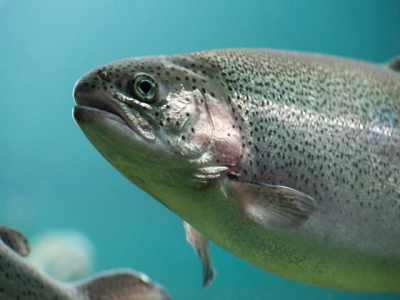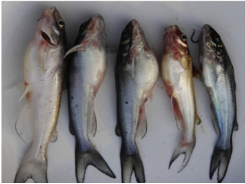Yeast-protein use may provide fishmeal alternative for trout feeds

Use of a yeast-based protein and synthetic amino acids can maintain trout growth when replacing fishmeal, but more work is needed to understand the ingredients role in amino acid catabolism, say researchers.
A research team based in Montana, New Mexico and Illinois examined the influence of prebiotics on gut microbes in rainbow trout feeds with a level of grain distiller dried yeast (GDDY) protein.
“The present study employed a metagenomic technique to investigate nutrient utilization in the midgut of rainbow trout,” the researchers said. “In particular, microbial contributions to amino acid catabolic processes were assessed in trout fed a nutritionally stressing diet with two common prebiotics in order to provide a more complete understanding of the mechanistic processes involved in amino acid utilization when alternative proteins are employed in aquaculture.”
The researchers found that all of the diets supported fish growth and production, however, feed intake was higher for fish on the diets with GDDY protein and feed efficiency was reduced. Microbial genes connected to branched-chain amino acid metabolism were increased for fish on the 75% GDDY diet.
“The results from this study indicate the potential for microbially-mediated catabolism of the non-essential amino acids, and suggest this activity may significantly influence efficient utilization of dietary nitrogen in the yeast-based protein diet,” they said.
Why prebiotics and GDDY?
Prebiotics have been linked to improved feed efficiency, weight gain and boosted growth rate in rainbow trout, the researchers said. The feed additives are not endogenously digestible by the host but can stimulate the growth of beneficial microbes.
In previous fish feeding studies, the addition of mannooligosaccharides has been linked to improved survival, immune response and growth, but the results are inconsistent.
“Grobiotic-A (GroA), a mixture of partially autolyzed brewer's yeast, dairy ingredient components and dried fermentation products, is another commercially available prebiotic that is gaining attention in fish nutrition studies,” they said. “Although GroA is reported to lower pathogenic bacteria, information on how it specifically alters microbial compositions in the gastrointestinal tract (GIT) in these fishes is lacking.”
The GIT is an important location for the digestion and metabolism of endogenous and exogenous amino acids in fish, the researchers said. “The mucosa of the small intestine catabolizes non-essential amino acids (glutamine, glutamate and aspartate), which supplies oxidative fuels to the GIT mucosa and also serve as precursors for intestinal synthesis of proteins, pyrimidine, purines, proline, nitric oxide and glutathione,” they added.
Essential amino acids are oxidized there and the rate of amino acid metabolism in the intestine is set by enteral and parenteral amino acid availability, the researchers said.
There also has been observation of the fermentation of leucine, isoleucine, valine and branch-chain amino acids (BCAA) for use by GIT microbiota.
It is not clear how dietary protein sources alter the catabolism of amino acids, however, this information could be relevant to improve nitrogen use when using alternative protein ingredients in diets, they said.
“In addition, amino acid catabolism by the GIT mucosa plays an important role in modulating absorbed amino acids entry into the portal circulation, with differences in the appearance of amino acids in the portal circulation that may not reflect their availability to the extra-intestinal tissue."
Amino acid catabolism has a role in protein turnover, they said, adding “postprandial amino acids concentrations are influenced by protein sources, resulting in differences in appearance between essential amino acids and non-essential amino acids.”
Recent research suggests that hepatic glutamate dehydrogenase (GDH) is linked to poor nitrogen retention efficiency, the researchers said.
Changes in concentration may be tied to increased energy demand – in rainbow trout, it is “negatively correlated” with the efficiency of nitrogen retention.
“However, the mechanistic process by which catabolized amino acids are deaminated is not fully understood, especially when there are exchanges of amino acids between the GIT microbiota and the host,” they said.
GDDY is a single-cell yeast-based protein that provides a high protein level and has been used previously in rainbow trout feeds when supplemented with synthetic amino acids, they said.
However, adding more than 15-18% has a negative influence on efficient feed use, but the influence of a prebiotic used in conjunction with a “nutritionally stressing diet,” like GDDY are unknown.
Feeding trial details
In the 12-week feeding trial, fish were given one of 12 diets with one of three levels of GDDY protein at 0%, 50% or 75% as a fishmeal replacement and one of four prebiotic amounts – 0%, 0.4% or 1% mannooligosaccharides (MOS) or 1% GroBiotic A, the researchers said.
“All diets were labeled using yttrium as inert marker and were formulated at 40% crude protein and 20% crude lipid, supplemented with lysine, methionine and threonine balanced to the rainbow trout fillet ideal amino acid targets of 3.8%, 1.3% and 2.1%, respectively,” they said.
Feeds were pelletized in a cooking extrusion system, they added.
Fish were weighed monthly, and the weight gain, feed conversion ratio (FCR) and feed intake were established at the tank level, they said.
A selection of fish was sampled at the start of the feeding trial to establish initial whole-body proximate composition.
At the end of the trial, a sample of fish on each diet was harvested to determine the final whole-body composition, visceral somatic index (VSI), hepatosomatic index (HSI), filet ratio and the digestive system of a selection of fish was collected, said the researchers. Fecal samples also were collected from remaining fish.
Additionally, three fish from each tank were collected for DNA extraction from the midgut of the GIT, they said.
“To better understand changes in the functional potential of the midgut microbiota in response to increasing levels of GDDY with corresponding poor feed utilization observed with fish fed the 75% GDDY diet, shotgun metagenomic sequencing was carried out to compare only samples from 0% GDDY and 75% GDDY diets."
Results
Overall, fish survival ranged from 98-100% with no differences among the diets, the researchers said.
Growth was not altered by the inclusion of GDDY in the diet, no significant effects were seen for the prebiotics or on the interaction between the prebiotics and GDDY inclusion levels on trout growth.
Weight gain was similar for fish on all diets, they said. However, feed intake increased linearly as more GDDY protein was added to the diet, and feed efficiency was reduced.
“No significant difference on VSI, HSI and FR with increasing GDDY levels, prebiotic supplementation or their interaction on the body indices of rainbow trout fed these dietary treatments,” they said. No major differences were found for whole-body lipid, energy or protein, they added.
Adding the prebiotics did not change digestibility of the diets, they said.
“The amino acid profile of the GDDY diets used in the present study were expected to meet the nutrient requirements of rainbow trout because the diets were formulated using the digestible amino acid composition of the GDDY protein,” the researchers said. “Moreover, since no negative effect resulted from the diet on the absorptive capacity of rainbow trout, based on histological observations and the comparable growth performance between fishmeal- and yeast-based proteins, GDDY has potential as a protein source in rainbow trout, which can replace fishmeal protein up to 75%.”
Amounts of acetic, propionic, butyric, isovaleric and valeric acids were similar for fish on all diets, they said. However, there was an interaction between prebiotics and GDDY on rodlet cells.
An analysis of microbiota in the gastrointestinal tract found that there were more fungal phyla Ascomycota and Basidiomycota along with the bacterial phylum Actinobacteria in the gut of fish getting one of the diets including GDDY protein, they said.
Fish on the 75%-GDDY diet also had higher levels of microbial genes linked to branched-chain amino acid metabolism and elevated glutamate dehydrogenase clusters.
“Differences in feed utilization related to amino acid catabolism were seen in rainbow trout fed yeast-based diet,” the researchers said. “Greater numbers of microbial genes related to glutamate dehydrogenase observed in fish fed the yeast-based diet suggest microbes were competing for dietary amino acids resulting in poor utilization of high levels of GDDY in rainbow trout.”
Source: Aquaculture
Authors: O.Betiku, C.Yeoman, T. Gaylord, G. Duff, T. Hamerly, B. Bothner, S. Block, W. Sealey
Related news
Tools

Phối trộn thức ăn chăn nuôi

Pha dung dịch thủy canh

Định mức cho tôm ăn

Phối trộn phân bón NPK

Xác định tỷ lệ tôm sống

Chuyển đổi đơn vị phân bón

Xác định công suất sục khí

Chuyển đổi đơn vị tôm

Tính diện tích nhà kính

Tính thể tích ao




 Super grouper: advances in RAS production in Asia
Super grouper: advances in RAS production in Asia  A fresh approach to understanding aquaculture
A fresh approach to understanding aquaculture